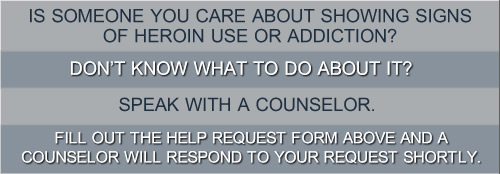
How To Identify Signs Of Heroin Use
The signs of heroin addiction are not always recognizable in the early stages. The strange behavior of the addict can be mistaken as response to certain stressful situations. However, it is important to know the signs and symptoms of heroin use because of the simple fact that being able to spot heroin dependency may save an addict from further suffering.
Heroin is among the more addictive drugs because of the very short time that it takes in reaching the brain. Heroin is most famous for being injected into the body through hypodermic syringes. The drug can also be smoked or snorted. Injections of the drug take the least time to reach the brain. Heroin is processed from morphine which in turn is synthesized from poppy seeds. Heroin is also known by other street names such as smack, black tar, brown sugar, etc., among others.
Signs of Heroin Use
The 1990s saw fashionable heroin users pictured as gaunt and angular faced. They were shown to have pale white and pasty skin. They had dark circles under their eyes. Many who saw the pictures did not understand that they looked that way because of the actual effects of using the drug. Heroin drug harms not only the body, but also the mind.
Under the influence of heroin, a person is seen to exhibit a great amount of calmness. However, when the time approaches for their next dose, a rapid change in behavior can be seen. This is because withdrawal symptoms take over. Spotting withdrawal symptoms of heroin is the best way to spot an individual's dependency on the drug. The withdrawal symptoms reveal that the person has used the drug enough number of times after which the body has developed an affinity for the drug. They grow very anxious and sometimes become sick. Trembling of the body may also be seen.
Physical signs of heroin use include injection marks on the arms, legs and feet. This is because of injecting the drug with hypodermic needles. If they regularly snort heroin, the person ends up with frequent nosebleeds. Developing respiratory issues more frequently is also indicative of increasingly heavy use of heroin. Other paraphernalia that indicate drug use are burned silver spoons, aluminum foils with burn marks, missing shoelaces that often serve as tie-off for the drug injection sites in the arms and legs, etc. Over time, heroin users also develop HIV/AIDS or hepatitis from using shared and infected needles.
Behaviorally, a heroin addict becomes very secretive of his/her actions for fear of the addiction being revealed to the people close to them. They are always agitated and short tempered. They do not like being asked questions. They generally isolate themselves from the people that they have known. They are also seen to start socializing with new people and form new friends.
Under the influence of heroin, the drug users say and do things that they are not habituated to otherwise. This could mean trouble for them, both social and legal. Heroin users dependent on the drug lose the ability to maintain relationships at home and at work. Heroin addicts frequently absent themselves from work. Most often this costs them their jobs. Day-to-day habits like bathing or eating may also change. Heroin addiction usually turns expensive with increased use of the drug and many a time heroin addicts are known to resort to stealing money and lying to procure the regular supply of the drug required to feed the addiction.
A heroin user is particularly not interested in keeping up a clean and good appearance. They have disheveled hair and do not bathe as regularly as they should. They develop a body odor because of this. The gait of the heroin user is slow and his/her pupils are constricted. A heroin user has trouble remembering things and events. They develop speaking problems and have a slurred speech. They are generally disoriented in thinking and do not communicate effectively when under the influence of the drug. They wear long pants and clothes with long sleeves even in warm weather to hide injection marks.
When heavily influenced by heroin, a person is usually aggressive and hostile towards members of family, friends, and those around them. Changes occur in the body weight and sleep patterns of the drug addict. 'Nodding out' or appearing to suddenly fall asleep is a common occurrence of acute heroin influence. They also develop a craving for sweets. They are nutritionally challenged as their diet is severely compromised under the influence of the drug. They appear malnourished and skinny. Many addicts experience lowered libido.
Mental problems frequently accompany regular heroin use. They display all symptoms of depression including a loss of interest in life and hobbies that otherwise interest them. Paranoia is also a common symptom of heroin addiction.
Withdrawal Symptoms of Heroin
Heroin withdrawal is an unpleasant experience for the drug user. It may not be very dangerous for a healthy individual but it worsens as addiction increases. Withdrawal typically worsens pre-existing conditions such as bipolar disorder and anxiety. Depression and mood swings are known to exist even long after the end of the physical withdrawals. Users experience insomnia.
Many of the withdrawal symptoms resemble that of the flu. The user experiences body pain, runny nose and coughing. Gastrointestinal disturbances include nausea, diarrhea and vomiting. Fevers and chills are also common. The restless leg syndrome or continuous shaking of the legs is another common feature.
The withdrawal symptoms are a signal to the brain that the body requires more of the drug. The user takes more of heroin each time just to keep those powerful feelings away and this can typically result in heroin overdose.
Heroin Overdose
The symptoms of heroin overdose include shallow breathing, difficulty in breathing, discolored tongue, convulsions, lips and fingertips tinged with a blue color, extremely constricted pupils, muscle spasms, and weak pulse, among others. In rare cases, the heroin user can go into a coma.
Learning about the signs of heroin use gives a better understanding of the addiction problem and how to best deal with it when someone close is involved.
- Questions?
